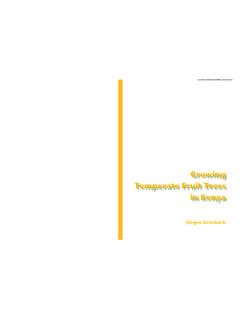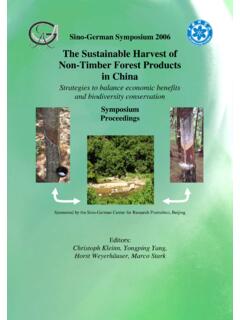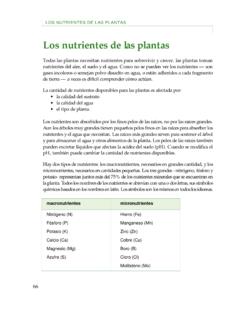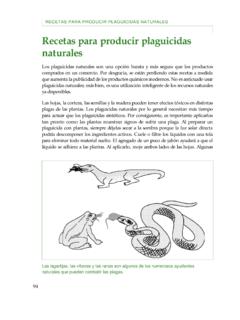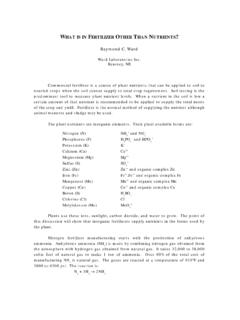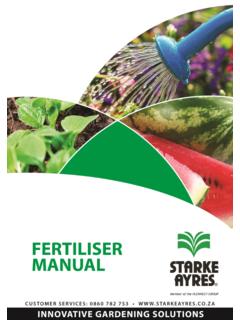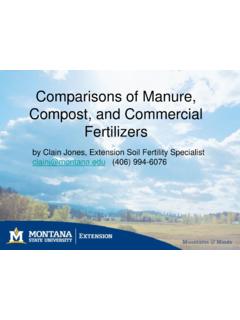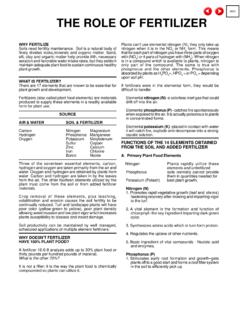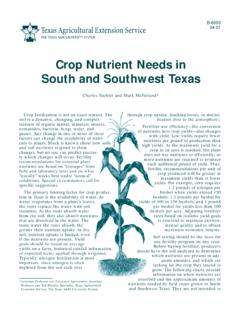Transcription of Plant nutrients - World Agroforestry Centre
1 7 Plant NUTRIENTS61 Plant nutrientsAll plants require nutrients to survive and grow. plants take nutrients from the air, thesoil, and the water. Because you cannot see nutrients they are colourless gases or are likedust dissolved in water or stuck onto each piece of soil it is sometimes hard to under-stand how they quantity of nutrients available to the plants is affected by: substrate quality water quality Plant are taken up by the fine root hairs, not by the big roots. Even the verylargest of trees have many small, fine root hairs to absorb the nutrients and water they larger roots are used for supporting the tree and for storage of water and other plantfood.
2 The root hairs can also excrete liquids that affect the acidity of the soil (pH). When thepH changes, the amount of nutrients available may also are two sorts of nutrients : macronutrients, required in large quantities, andmicronutrients, required in small quantities. The big three, nitrogen, phosphorus and potas-sium, together comprise over 75% of the mineral nutrients found in the Plant . All nutrientsare abbreviated by one or two letters, their chemical symbols that are based on their Latinnames. The symbols are the same in all (N)Iron (Fe)Phosphorus (P)Manganese (Mn)Potassium (K)Zinc (Zn)Calcium (Ca)Copper (Cu)Magnesium (Mg)Boron (B)Sulphur (S)Chlorine (Cl)Molybdenum (Mo)7 Plant NUTRIENTS7 Plant NUTRIENTS62 The only way to know if one nutrient is missing is to analyse the leaves, stems and rootsin the laboratory and compare this to published values for that species.
3 If values are not known,fertilizer trials might show what is lacking. This would involve adding different types of nutri-ents and at different levels during the growing season. Soil analyses can show what is in the soil,but might not indicate what is available for the plants to use, and you might need a soil scientistto help interpret these balance and nutrient deficienciesPlants (like people) need a balanced diet . They need all 13 nutrients to remain one is missing, the Plant will not grow well. Poor Plant nutrition causes plants to grow slowlyin the nursery and in the field, and to be more susceptible to people confuse the symptoms of nutrient deficiencies with those of too much ornot enough shade or water.
4 In fact, all three factors, shade, water and nutrients affect plantgrowth, and interact to produce healthy plants . A Plant that grows in full light with abundantmoisture and receives all the 13 nutrients will grow fast and have a dark green colour in itsleaves. A Plant that grows slowly in the shade may also have dark green leaves, but whenexposed gradually to the sun, the leaves may turn yellow. This does not mean that plants do notlike full sun it might indicate a nutrient deficiency which did not show up in the shadebecause the Plant did not have enough light to stimulate fast growth. Together, water, shade and nutrients must be monitored andadjusted to produce quality takes practice to learn the signs identifying a missingnutrient or nutrients , but you can learn to do so, and some of thesigns are common to many plants .
5 A good nursery practice is tocarefully monitor the leaves of your plants for signs of nutrientdeficiency, and correct them with a better substrate or with ferti-lizer. The symptoms can vary for each species the lists on thenext pages are only a general fertilizersInorganic fertilizers are mined from the soil, or produced during complicated chemicalreactions. A good nursery practice is to read the fertilizer labels. This allows you to apply whatthe plants need without wasting nursery resources. fertilizers contain only Plant nutrients ; theyare not used to combat Plant diseases or insects. Inorganic fertilizers do not improve theCarefullymonitor theleaves of yourplants for signsof nutrientdeficiency.
6 7 Plant NUTRIENTS7 Plant NUTRIENTS63 Common nutrient deficiency symptomsMacronutrientsNitrogen: This is a mobile nutrient , which means that when nitrogen is deficient, plants move it from the older foliage to the younger, actively growing leaves. Theolder leaves (the ones lower on the stem of the tree) become yellow first, whilethe new leaves remain : The entire seedling is stunted, especially during early on the species, the leaves may become dull green, yellow or purple-tinged. The purpling of leaves is a classic symptom, but sometimes there are nocolour differences in leaves, so visual diagnosis is not always reliable. The purplecolour should not be confused with new leaves that often appear purple or redwhen they first flush : Symptoms appear in older leaves first.
7 These start to yellow at theedges, and have some green at the base. Later, leaf edges turn brown and maycrinkle or curl and small necrotic (dead) spots may appear. plants may wilt, eventhough sufficient water is available in the substrate. When deficiencies are severe,leaves will : This is difficult to detect because signs include slow growth, and die-back of bud or root tips. Seedlings will have stubby little roots with brownishdiscoloration. The problem is most common in very acidic soils. A well-developedroot system with many fine root hairs is important for calcium : This nutrient is commonly deficient in coarse-structured soils andin acidic soils. Uptake may be blocked if there is too much potassium in the nitrogen, magnesium is a mobile nutrient , so deficiency symptoms show upin the older leaves first.
8 These leaves show a very characteristic yellowing betweenthe veins or ribs, and they appear : plants will be slightly stunted. This is not a mobile nutrient , so thesymptoms show up on younger leaves which are initially light green, but eventuallydevelop scorched and curled margins. Dry areas can form along the marginsand then spread inward to the leaf midrib. 7 Plant NUTRIENTS7 Plant NUTRIENTS64should carefully consider the cost and benefit of buying these fertilizers are commonly given names like 17-17-17 , or 10-30-10 .What do the numbers mean? They represent the percentages of nitrogen (N), phosphorus(P), and potassium (K) in the fertilizer 17% N, 17% P, 17% K.
9 In this case, 51% of themixture is made up of N-P-K, and the rest is inactive material used to help spread thefertilizer evenly. Urea contains only N, and is labelled as 46-0-0. Urea is very strong andcan easily burn the plants if too much is fertilizers can be mixed into the substrate or into the irrigation water, orbe applied to older plants on the soil surface. It is better to mix the fertilizer directly into thesubstrate before planting the seed because the roots can avoid or seek the fertilizer as theyneed it. Use only small quantities such as 2 or 4 grams (1/2 teaspoon) per 1 kg of soil. It isbetter to add too little then too much. You need to experiment with different levels.
10 Plantsshould respond within two nutrient deficiency symptomsMicronutrientsMicronutrient deficiencies are difficult to diagnose because often more than onenutrient is missing. Only the most common symptoms are listed : Deficiency is common on alkaline or calcareous soil (pH above 7). Youngerleaves become yellow to white and dry : The tissue between the veins mottles, while the veins remain greenand are surrounded by a band of green : New leaves are yellow at the tips and often become : The deficiency affects the terminal bud which yellows, dries out anddies. plants grow slowly. substrate physical properties, whereas organic material such as compost does. Inorganicfertilizers are also expensive and not always available in the stores.

